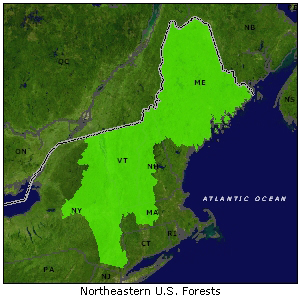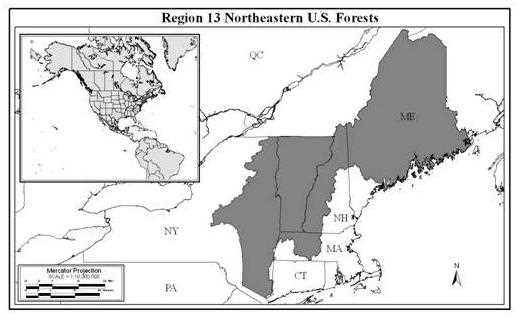Level IV Ducks Unlimited conservation priority area, critical breeding habitat for American black ducks and other waterfowl species

The Northeastern U.S. Forests region is characterized by low relief, low hills and low mountains. Marshes, rivers, lakes, poorly drained depressions, moraines, eskers, out-wash plains and other glacial features compose most of the wetlands in the area. American black ducks represent an important breeding population in northeastern states, particularly Maine. Black duck populations have declined and not recovered to the goals of the North American Waterfowl Management Plan. DU's current approach for black ducks is to protect large blocks of relatively undisturbed breeding habitat in the Northeastern U.S. forests. Partnerships with state and federal wildlife agencies are being expanded and new partnerships with corporate timber industry are being established to protect and enhance breeding habitat.

Maine | New Hampshire | New York | Massachussetts | Vermont

The Northeastern U.S. Forests Waterfowl Conservation Region (Region 13*) overlaps almost exclusively with the Atlantic Northern Forest Ecoregion of the Commission for Environmental Cooperation (IAFWA 1998), except for a narrow band representing the Lower Great Lakes/St. Lawrence Plain that transverses the North-South border between New York and Vermont. It includes the non-coastal regions of northern Maine, New Hampshire, Vermont and northeast New York. This region is included in its entirety in the Atlantic Coast Joint Venture (ACJV) of the NAWMP. This region is within the Laurentian Mixed-Forest Province and is characterized by low relief, low hills and low mountains. Marshes, rivers, lakes, poorly drained depressions, moraines, eskers, out-wash plains, and other glacial features compose most of the wetlands in the area. Vegetation is transitional between the deciduous forests to the south and the boreal forest to the north. Soils vary greatly but are generally poor and relatively infertile in the Atlantic Northern Forests; however, they are more fertile in the Eastern Great Lakes Lowlands. Soils vary greatly including combinations of peat, muck, marl, clay, silt, sand, gravel and boulders.
Approximately 85% of the 260,000 ha of forest within the Northeastern U.S. Forests region are in private ownership (Harper et al. 1990). Historically, the vast majority of land has been owned by timber companies and thus managed for forest products. The character of this region has changed relatively little over time, compared to other regions of New England where
extensive land use changes have occurred due to a strong economy and population growth. Concerned about future change, a 1990 USFS and Governors Task Force on Northern Forest Lands warned that changes in land ownership from the timber industry to recreational property here would likely have an adverse impact on open space, forestry, farming and recreational uses on private lands (Harper et al. 1990). In the last decade a downturn in the economy of the forests industry has led to millions of acres of timber company lands being put up for sale. At the same time, a strong regional economy has put much of this land at risk to land developers and prospectors interested in recreational developments. Fortunately, most of this land is being protected through fee title acquisition and conservation easements, by a coalition of state and federal wildlife agencies and private, non-profit conservation agencies. This is occurring throughout the region and most of this area is going into public ownership of State Wildlife Management Areas and NWRs.
The most significant waterfowl characteristic in the Atlantic Northern Forest is the contribution of this region to the breeding habitat of the black duck. Common mergansers, common goldeneye, wood ducks and ring-necked duck, also breed in relatively significant numbers in the forested zone. Since surveys of breeding ducks began in the U.S. in 1966, most states have seen a decline in numbers of black ducks. Maine, New Hampshire and Vermont are the exception in that black duck numbers have not changed much in the past 30 years. Breeding black ducks are linked to forests in general and beavers in particular (Petrie pers. com.). Growth in beaver populations throughout northeastern forests has provided an increase in the quantity and quality of breeding habitat for black ducks.
In addition to black ducks, mallards, wood ducks and green-winged teal are common breeding waterfowl in the Lower Great Lakes/St. Lawrence Plain of Northeast New York. Soils are more fertile and suitable for agriculture, lending them beneficial for breeding habitat. The quality of habitat in both the Atlantic Northern Forest and Lower Great Lakes/St. Lawrence Plain can be considered questionable. Acid rain and other pollutants may be affecting waterfowl use and productivity, but that has yet to be determined. The Connecticut and Hudson Rivers provide an important migration corridor for ducks and geese as they make their way down to the New York Bight and the Atlantic Coast.
*Region 13 - NABCI Bird Conservation Region 13 & 14 – U.S. only.( Atlantic Northern Forest , Lower Great Lakes/St. Lawrence Plain)
The Northeast Forest region provides a unique forest habitat not found elsewhere in the U.S. and, consequently, supports a varied community of plant and animal species. It is reported that 225 bird species use this area during migration and breeding periods (U.S. Forest Service 1979) and virtually the entire worlds Bicknell's thrush breed on mountaintops in this region. Other important forest birds include the Canada warbler and bay-breasted warbler (IAFWA 1998). This region is also critical habitat to mammals, such as moose and black bear, which require vast areas of wilderness for survival. Lakes, rivers and streams throughout this region provide important habitats for a wide variety of cold and warm water fish, amphibians and reptiles.
American black ducks represent an important breeding population in northeastern states, particularly Maine. Black duck populations have declined and not recovered to the goals of the North American Waterfowl Management Plan. The current approach for black ducks is to protect large blocks of relatively undisturbed breeding habitat in the northeast US forest. Partnerships with state and federal wildlife agencies are being expanded and new partnerships with corporate timber industry are being established to protect and enhance breeding habitat.
Ducks Unlimited uses cookies to enhance your browsing experience, optimize site functionality, analyze traffic, and deliver personalized advertising through third parties. By continuing to use this site, you agree to our use of cookies. View Privacy Policy